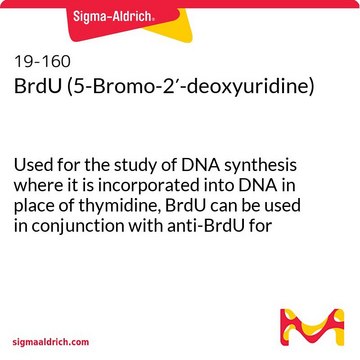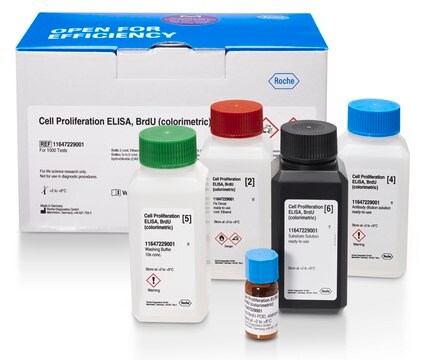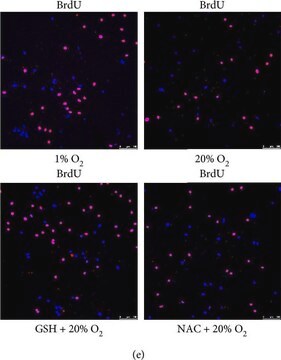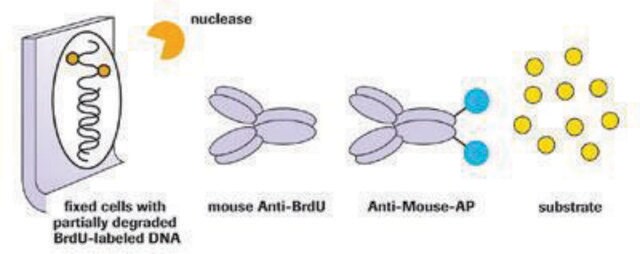QIA58
BrdU Cell Proliferation Assay
This proliferation assay is a non-isotopic immunoassay for quantification of BrdU incorporation into newly synthesized DNA of actively proliferating cells.
Synonym(s):
Bromodeoxyuridine Assay
About This Item
Recommended Products
Quality Level
usage
sufficient for 1000 tests
sufficient for 200 tests
packaging
pkg of 1 96-well plate(s)
manufacturer/tradename
Calbiochem®
storage condition
OK to freeze
avoid repeated freeze/thaw cycles
input
sample type intact cells
sample type intact cells
detection method
colorimetric
shipped in
wet ice
storage temp.
−20°C
General description
Components
Warning
Specifications
Principle
Storage and Stability
Prior to use:
1. Remove the Fixative/Denaturing Solution and place at room temperature for at least 4 h prior to use. Precipitates that may occur while cold should go back into solution.
2. Reconstitute the Peroxidase Goat Anti-Mouse IgG with the appropriate volume of 1X PBS.
• For the 200 test kit, reconstitute Peroxidase Goat Anti-Mouse IgG in 125 µl of 1X PBS. Use Conjugate Diluent for any further lot-specific dilution.
• For the 1000 test kit, reconstitute Peroxidase Goat Anti-Mouse IgG in 250 µl of 1X PBS. Use Conjugate Diluent for any further lot-specific dilution.
Allow solution to stand at room temperature for 10 min. (or until solution is clear). Divide into small aliquots; aliquots not to be used that same day should be stored at -20°C in a non-frostfree freezer.
Once the kit components have been thawed for use:
• The BrdU label and 100X Anti-BrdU Antibody should be divided into small aliquots and stored at -20°C in a non-frostfree freezer with the Peroxidase Goat Anti-Mouse IgG; avoid multiple freeze/thaw cycles.
• All the other kit components (Substrate, Antibody Diluent, Conjugate Diluent, 20X Plate Wash Concentrate, Fixative/Denaturing Solution, Stop Solution) should be stored at 4°C.
Other Notes
Muir, D., et al. 1990. Analytical Biochemistry185, 377.
Lanier, T. L., et al. 1989. Carcinogenesis10, 1341.
Magaud, J.-P., et al. 1988. J. Immunol. Methods106, 95.
Collins, S.J. 1987. Blood70, 1233.
Porstmann, T., et al. 1985. J. Immunol. Methods82, 169.
Raza, A., et al. 1985. Cytometry6, 633.
Morstyn, G., et al. 1983. J. Clin. Invest.72, 1844.
Gratzner, H.G. 1982. Science218, 474.
Legal Information
Signal Word
Danger
Hazard Statements
Precautionary Statements
Hazard Classifications
Carc. 2 - Eye Irrit. 2 - Flam. Liq. 2 - Met. Corr. 1 - Muta. 1B - Repr. 2 - Skin Irrit. 2 - Skin Sens. 1
Storage Class Code
3 - Flammable liquids
Flash Point(F)
69.8 °F
Flash Point(C)
21 °C
Certificates of Analysis (COA)
Search for Certificates of Analysis (COA) by entering the products Lot/Batch Number. Lot and Batch Numbers can be found on a product’s label following the words ‘Lot’ or ‘Batch’.
Already Own This Product?
Find documentation for the products that you have recently purchased in the Document Library.
Customers Also Viewed
Our team of scientists has experience in all areas of research including Life Science, Material Science, Chemical Synthesis, Chromatography, Analytical and many others.
Contact Technical Service













